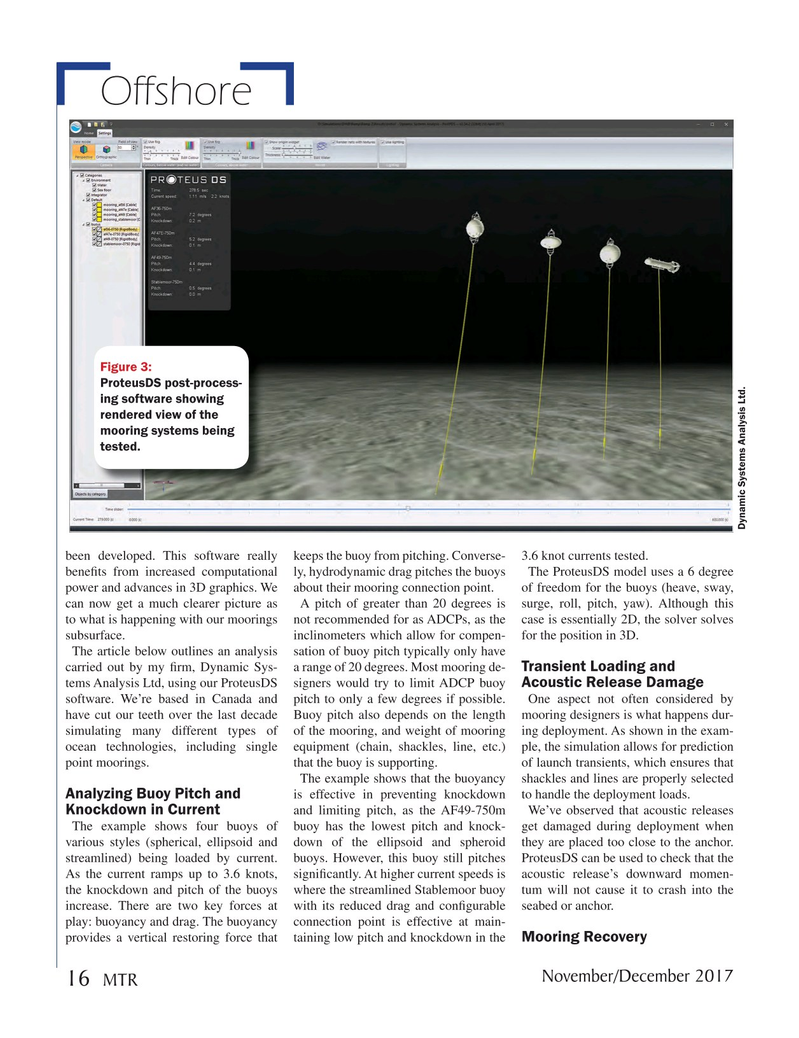
Page 16: of Marine Technology Magazine (November 2017)
Acoustic Doppler Sonar Technologies ADCP & DVLs
Read this page in Pdf, Flash or Html5 edition of November 2017 Marine Technology Magazine
Offshore
Figure 3:
ProteusDS post-process- ing software showing rendered view of the mooring systems being tested.
Dynamic Systems Analysis Ltd.
been developed. This software really keeps the buoy from pitching. Converse- 3.6 knot currents tested. bene? ts from increased computational ly, hydrodynamic drag pitches the buoys The ProteusDS model uses a 6 degree power and advances in 3D graphics. We about their mooring connection point. of freedom for the buoys (heave, sway, can now get a much clearer picture as A pitch of greater than 20 degrees is surge, roll, pitch, yaw). Although this to what is happening with our moorings not recommended for as ADCPs, as the case is essentially 2D, the solver solves subsurface. inclinometers which allow for compen- for the position in 3D.
The article below outlines an analysis sation of buoy pitch typically only have carried out by my ? rm, Dynamic Sys- a range of 20 degrees. Most mooring de- Transient Loading and tems Analysis Ltd, using our ProteusDS signers would try to limit ADCP buoy Acoustic Release Damage software. We’re based in Canada and pitch to only a few degrees if possible. One aspect not often considered by have cut our teeth over the last decade Buoy pitch also depends on the length mooring designers is what happens dur- simulating many different types of of the mooring, and weight of mooring ing deployment. As shown in the exam- ocean technologies, including single equipment (chain, shackles, line, etc.) ple, the simulation allows for prediction point moorings. that the buoy is supporting. of launch transients, which ensures that
The example shows that the buoyancy shackles and lines are properly selected
Analyzing Buoy Pitch and is effective in preventing knockdown to handle the deployment loads.
Knockdown in Current and limiting pitch, as the AF49-750m We’ve observed that acoustic releases
The example shows four buoys of buoy has the lowest pitch and knock- get damaged during deployment when various styles (spherical, ellipsoid and down of the ellipsoid and spheroid they are placed too close to the anchor. streamlined) being loaded by current. buoys. However, this buoy still pitches ProteusDS can be used to check that the
As the current ramps up to 3.6 knots, signi? cantly. At higher current speeds is acoustic release’s downward momen- the knockdown and pitch of the buoys where the streamlined Stablemoor buoy tum will not cause it to crash into the increase. There are two key forces at with its reduced drag and con? gurable seabed or anchor. play: buoyancy and drag. The buoyancy connection point is effective at main- provides a vertical restoring force that taining low pitch and knockdown in the Mooring Recovery November/December 2017 16 MTR
MTR #9 (1-17).indd 16 MTR #9 (1-17).indd 16 11/28/2017 10:59:56 AM11/28/2017 10:59:56 AM

 15
15

 17
17
